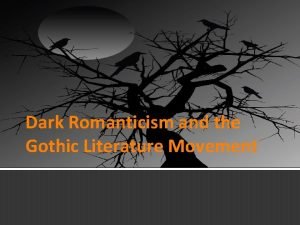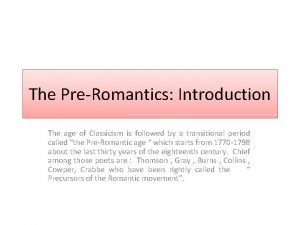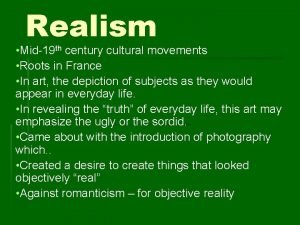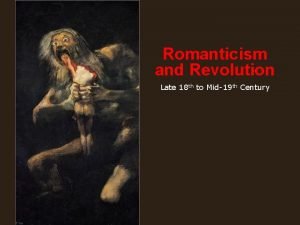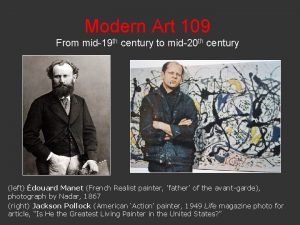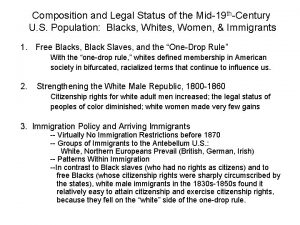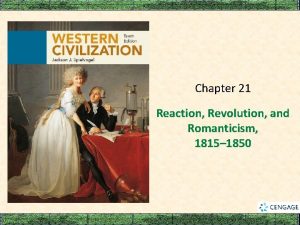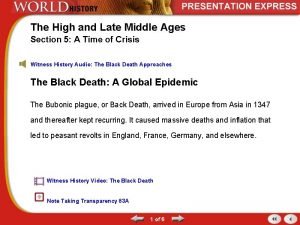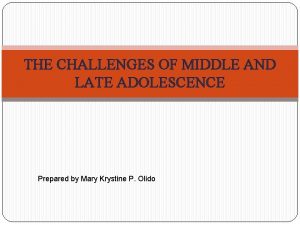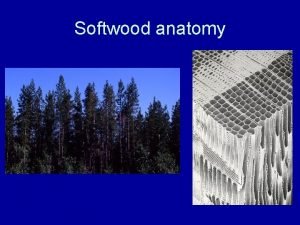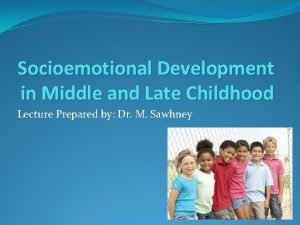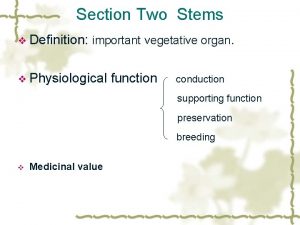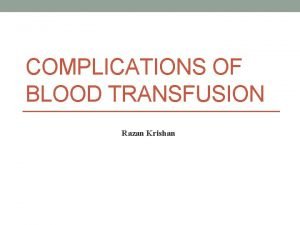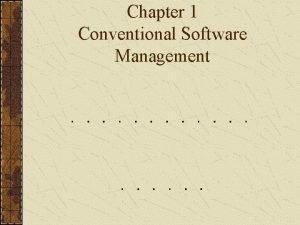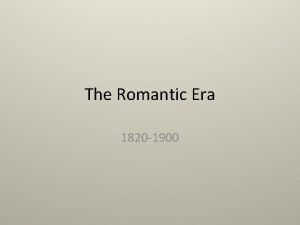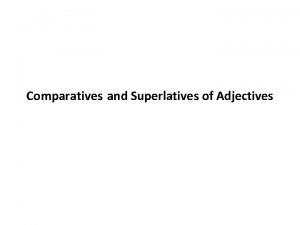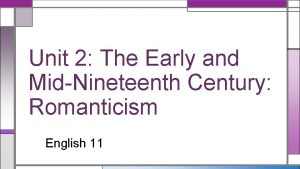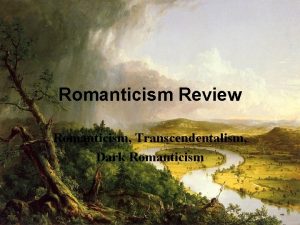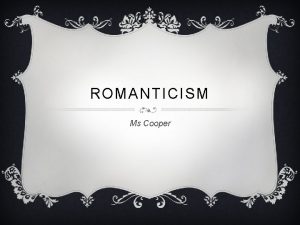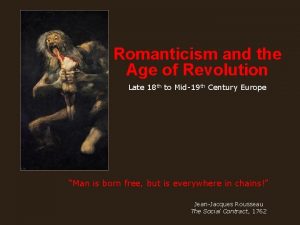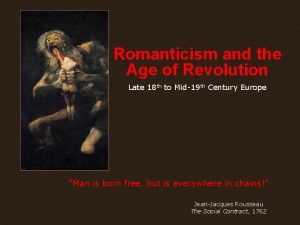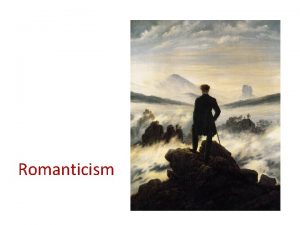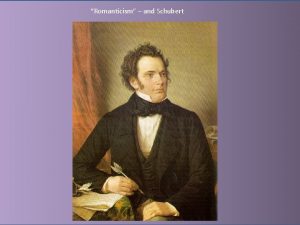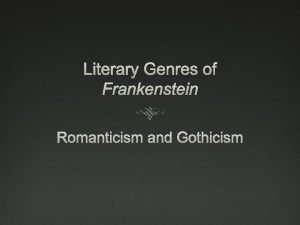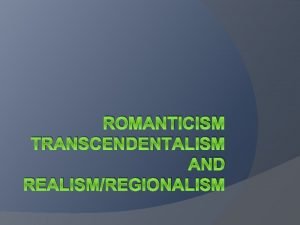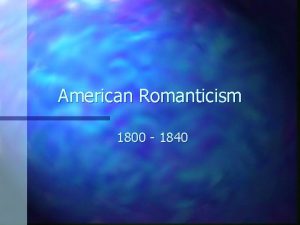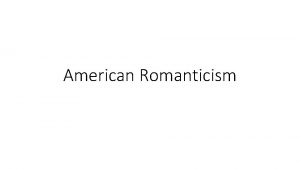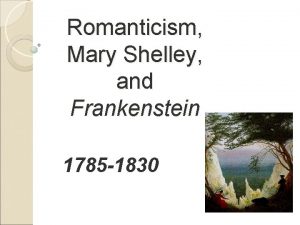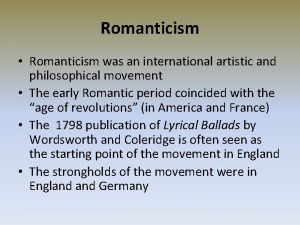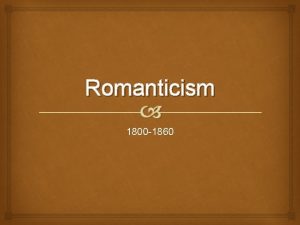Romanticism and Revolution Late 18 th to Mid19







![FRANCISCO GOYA (Spanish, 1746 -1828), The Sleep [or Dream] of Reason Produces Monsters (El FRANCISCO GOYA (Spanish, 1746 -1828), The Sleep [or Dream] of Reason Produces Monsters (El](https://slidetodoc.com/presentation_image/92f04faf4fd6acfa2cba9dbbc9869cc7/image-8.jpg)























- Slides: 31

Romanticism and Revolution Late 18 th to Mid-19 th Century

HENRY FUSELI (1741 -1825, Swiss-British) The Nightmare, 1781. Oil on canvas, 3’ 4” x 4’ 2”. The Detroit Institute of the Arts. Fuseli is considered one of the major figures of the Romantic movement. Horror, fantasy, imagination, the subconscious – elements of the irrational or non-rational – fascinated him.

THE ‘MARA’ (detail from The Nightmare) from European mythology but also alludes to late 18 th century ideas about ‘savages’ and half human simians. His features have been taken as resembling Fuseli’s. ‘Mara’ are spirits who visit in the night, causing bad dreams – or who assault women sexually in their sleep.

“A monstrous creature whose bloodthirsty instinct was imprinted on every detail of its appearance, with 'burning eyes which long for moisture', and a 'face worthy of a murderer. ‘” WILLIAM BLAKE (English, 1757 -1827), The Ghost of a Flea, circa 1819 -20, tempera heightened with gold on mahogany support: c. 8. 5 X 6. 4 inches. One of Blake’s “Visionary Heads”

“I must create a system or be enslaved by another man's. ” - William Blake's America: A Prophecy, (plate 9 of 18), 1793, connecting recent American history with current events in France and Europe – the spread of revolution. Apocalyptic expectations of the Revolutionary epoch

“When he set a compass Upon the face of the deep” Proverbs 8: 27 Old Testament WILLIAM BLAKE, Ancient of Days, frontispiece of Europe: A Prophecy, 1794. Metal relief etching, hand colored, approx. 9 1/2” x 6 3/4” Neoclassical and Romantic

William Blake, Illustration from 'The Book of Job, ’ Behemoth and Leviathan, 8 x 6 inches, 1825 Line engraving, hand painted watercolor on paper
![FRANCISCO GOYA Spanish 1746 1828 The Sleep or Dream of Reason Produces Monsters El FRANCISCO GOYA (Spanish, 1746 -1828), The Sleep [or Dream] of Reason Produces Monsters (El](https://slidetodoc.com/presentation_image/92f04faf4fd6acfa2cba9dbbc9869cc7/image-8.jpg)
FRANCISCO GOYA (Spanish, 1746 -1828), The Sleep [or Dream] of Reason Produces Monsters (El sueño de la razón produce monstruos), plate 43 of 80 plates of series, Los Caprichos (The Caprices), 1798, etching and aquatint, 8 1/2” x 6” Ambiguous animal symbolism: owls (folly), bats (ignorance) "Fantasy abandoned by reason produces impossible monsters: united with her, she is the mother of the arts and the origin of their marvels. "

FRANCISCO GOYA, The Third of May 1808, 1814 (for Ferdinand VII), oil on canvas, approx. 8’ 8” x 11’ 3”. Museo del Prado, Madrid. Note the Franciscan priest about to be executed.

The Prado Museum, Madrid, Spain - 2008 Goya exhibition with The Second of May, 1808 (left) and The Third of May, 1808 (right), both painted in 1814.

Spanish War of Independence against French occupation, 1808 -1814 // “Guerrilla” (little war) FRANCISCO GOYA, (left) This is Worse, # 37; (right) Ravages of War, #40, from The Disasters of War series of 82 prints, etching, aquatint, and drypoint, 1810 -20, French atrocities: (left) mutilated Spanish man impaled on a tree; (right) women raped and murdered. Spanish guerrillas practiced atrocities against the French occupiers as well. Other prints in the series address the absolutism of the restored Spanish monarchy after 1814. Published 35 years after the artist’s death.

Francisco GOYA, Disasters of War: Scarred for Life, 1810 -20 To see all 80 prints in the series: http: //commons. wikimedia. org/wiki/Los_desastres_de_la_guerra

FRANCISCO GOYA, Saturn Devouring One of His Children, 1819– 1823. Detail of a detached oil wall painting now on canvas, 5 x 3 ft. Museo del Prado, Madrid. The horrors of both “reason” and “unreason. ” Monstrous side of humanity. This painting is one of 14 in a series known as the Black Paintings for Goya’s home outside Madrid, Quinta del Sordo.

Goya painted the so-called Black Paintings in oil directly on the walls of his home, the ‘La Quinta del Sordo, ’ the house of the deaf man, near Madrid, before he went into self-imposed exile in Bordeau, France, in 1823. 1900

THÉODORE GÉRICAULT (French, 1791 -1824) Raft of the Medusa, 1818– 1819. Oil on canvas, approx. 16’ x 23’. Louvre, Paris. French Romanticism - Note Baroque lighting and theatricality

Two of many preparatory studies Gericault made for The Raft of the Medusa

Theodore Gericault, Heads, oil on canvas, study for The Raft of the Medusa, 1818 -1819

Gericault’s Raft of the Medusa at the Louvre museum in Paris

EUGÈNE DELACROIX (French Romantic Painter, 1798 -1863). Death of Sardanapalus, 1826. Oil on canvas, approx. 12’ 1” x 16’ 3”. Louvre, Paris. Romanticism, Orientalism. Inspired by the poem of the same name by Lord Byron

EUGÈNE DELACROIX, Liberty Leading the People, 1830. Oil on canvas, approx. 8’ 6” x 10’ 8”. Louvre, Paris.

CASPAR DAVID FRIEDRICH (German Romantic painter, 1774 -1840), Abbey in the Oak Forest, 1810. Oil on canvas, 3' 7 1/2" X 5' 7 1/4". Staatliche Museen, Berlin. Nature as “the living garment of God. ” (Goethe)

CASPAR DAVID FRIEDRICH, Wanderer Above the Sea of Fog, 1818, Hamburg, Germany The Romantic Sublime landscape: beauty and fear. The yearning of the human spirit symbolically reflected in the landscape.

JOHN CONSTABLE (English, 1776 -1837) The Haywain, 1821. Oil on canvas, 4’ 3” x 6’ 2”. National Gallery, London. Nostalgia for the countryside of the artist’s childhood. Response to the effect of Industrial Revolution on rural England.

One of many cloud studies by Constable

JOSEPH MALLORD WILLIAM TURNER (English, 1775 -1851), The Slave Ship (Slavers Throwing Overboard the Dead and Dying, Typhoon Coming On), 1840. Oil on canvas, 2’ 12” x 4’ 5/16”. Museum of Fine Arts, Boston

Joseph Mallord William Turner, Rain, Steam, and Speed: The Great Western Railway, oil on canvas, 1844

Turner, detail of the locomotive from Rain, Steam and Speed: The Great Northern Railroad

JOHN NASH (English, 1752 -1835), Royal Pavilion, Brighton, England, 1815– 1818. Romanticism, Imperialism, Orientalism, Eclecticism

“Indian Gothic” Compare the Taj Mahal (16301653) in Agra, India, with The Royal Pavilion (below) 1815 -18 British control of India began in 1757, lasted 190 years, and ended in 1947.

Royal Pavilion at night

The Banqueting Room at the Royal Pavilion in Brighton from John Nash's Views of the Royal Pavilion (1826). 19 th Century British eclectic Orientalism
 Features of the gothic
Features of the gothic Pre romantic poet
Pre romantic poet Characteristics of impressionism
Characteristics of impressionism Mid19
Mid19 Mid19
Mid19 Mid19
Mid19 Mid19
Mid19 The romanticism (1795 — 1835) what is romanticism
The romanticism (1795 — 1835) what is romanticism Chapter 21 reaction revolution and romanticism
Chapter 21 reaction revolution and romanticism Russian revolution vs french revolution
Russian revolution vs french revolution Could the french revolution have been avoided
Could the french revolution have been avoided The third agricultural revolution
The third agricultural revolution The high and late middle ages section 5 quiz
The high and late middle ages section 5 quiz Middle and late adolescence challenges
Middle and late adolescence challenges Softwood anatomy
Softwood anatomy Middle to late childhood
Middle to late childhood Early wood and late wood difference
Early wood and late wood difference Garden path sentences
Garden path sentences Cognitive development of late childhood
Cognitive development of late childhood Complications of blood transfusion
Complications of blood transfusion Protracted integration and late design breakage
Protracted integration and late design breakage Complications of blood transfusion
Complications of blood transfusion Early childhood
Early childhood During the late 1800s farmers supported free and unlimited
During the late 1800s farmers supported free and unlimited Industrialists of the late 1800s used pools and trusts to
Industrialists of the late 1800s used pools and trusts to Late childhood physical development
Late childhood physical development Who rides so late through night and wind
Who rides so late through night and wind Comparative form of new
Comparative form of new Middle and late childhood
Middle and late childhood Dentinoenamel junction
Dentinoenamel junction Social and emotional development in late adulthood
Social and emotional development in late adulthood The early and mid-nineteenth century romanticism post test
The early and mid-nineteenth century romanticism post test
